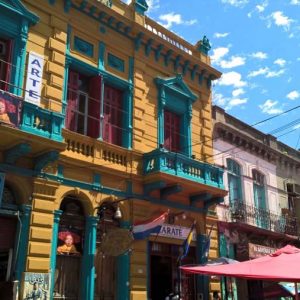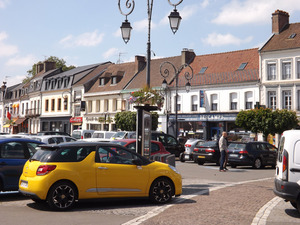
Whenever you fancy a brief visit to France, take the ferry and go to Calais. Less than an hour from there you will find the handsome little town of Montreuil-sur-Mer. Take the coast road and travel about 70 kilometres southbound towards Le Touquet. Montreuil-sur-Mer is France at its most elegant best and has much to entice the British traveller.
Montreuil is always busy with many shops, restaurants, bars and hotels. The local inhabitants scurry around with their commercial business but the ordinary French family life goes on as well, all at the same time. Watch it all for yourself in the cafes and streets. There is a large square in the centre. It serves as a free car park during the week but provides space for an energetic market on Saturday mornings. You can browse with the locals and buy almost anything that you like.
I have loved the charm of this French town for many years. There are so many quaint little houses in varying states of repair that provide a very picturesque, Gallic environment. The older properties have often been the subject of watercolour paintings that I relish so much. Have a look on the internet and find them for yourself.
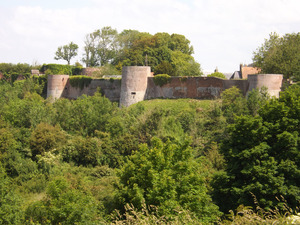 The higher part of Montreuil is surrounded by rampart fortifications built in the 17th century. You can walk around them easily and admire the panoramic view of the French countryside. The unfenced sheer drop of about a hundred feet just below your toes would never be allowed by the British health and safety brigade. A full circle stroll takes about half an hour and the views are a great spectacle. No one ever seems to fall over the edge. If you stay in the town overnight, take a walk around the ramparts at ground level as it gets dark. The experience is a little spooky but the children will love it. When you get back to the square, you will need a glass of something French to steady your nerves.
The higher part of Montreuil is surrounded by rampart fortifications built in the 17th century. You can walk around them easily and admire the panoramic view of the French countryside. The unfenced sheer drop of about a hundred feet just below your toes would never be allowed by the British health and safety brigade. A full circle stroll takes about half an hour and the views are a great spectacle. No one ever seems to fall over the edge. If you stay in the town overnight, take a walk around the ramparts at ground level as it gets dark. The experience is a little spooky but the children will love it. When you get back to the square, you will need a glass of something French to steady your nerves.
Literary pundits will be interested to know that Montreuil-sur-Mer was the setting for ‘Les Miserables’ by the illustrious writer Victor Hugo. The book’s main character, Jean Valjean, used to be the mayor of the town. There is a little museum close to the edge of the fortifications that deals with this association.
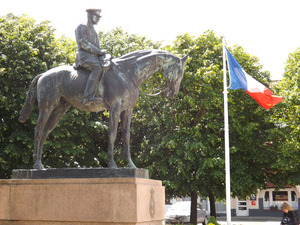 Montreuil was also the headquarters of the British army during the First World War. It sits a little away from the Western Front where much of the fighting took place. The ramparts protect a mini fortress that was the operations centre for General Douglas Haig. He was the chief of the British and Commonwealth expeditionary force despatched to fight in the trenches in 1914. This headquarters is open to the public. It is used as a museum representing many appropriate themes on a constantly changing basis. It is an eerie experience to follow the footsteps of Haig in the gloomy and damp environment. There is a very prominent statue of the General astride his horse, on the edge of the market square. He sits in front of an active theatre reminding visitors of the literary and Great War associations so closely associated with Montreuil. Much admiration for the British presence during the Great War is still held by the local people. A main route on the edge of the town square still has an active cafe bar called ‘The Douglas’.
Montreuil was also the headquarters of the British army during the First World War. It sits a little away from the Western Front where much of the fighting took place. The ramparts protect a mini fortress that was the operations centre for General Douglas Haig. He was the chief of the British and Commonwealth expeditionary force despatched to fight in the trenches in 1914. This headquarters is open to the public. It is used as a museum representing many appropriate themes on a constantly changing basis. It is an eerie experience to follow the footsteps of Haig in the gloomy and damp environment. There is a very prominent statue of the General astride his horse, on the edge of the market square. He sits in front of an active theatre reminding visitors of the literary and Great War associations so closely associated with Montreuil. Much admiration for the British presence during the Great War is still held by the local people. A main route on the edge of the town square still has an active cafe bar called ‘The Douglas’.
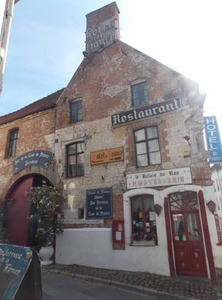 I have often briefly stayed in Montreuil-sur-Mer during my travels in France. On one occasion the ‘Circus Buffalo’ came to town and they were setting themselves up on the market square. The culture was a little American but all of the performers were French. It appealed exactly to the Gallic taste and I bought a ticket for myself. Many of the families of the town visited and they all loved it without pretention. The acts were traditional and included obscure animals to impress the youngsters. All were invited to participate if they wished. The French children loved it all and returned home afterwards laughing with their parents. By the following morning the circus had packed up and left town. There was not a trace of any discarded debris or rubbish left on the central square.
I have often briefly stayed in Montreuil-sur-Mer during my travels in France. On one occasion the ‘Circus Buffalo’ came to town and they were setting themselves up on the market square. The culture was a little American but all of the performers were French. It appealed exactly to the Gallic taste and I bought a ticket for myself. Many of the families of the town visited and they all loved it without pretention. The acts were traditional and included obscure animals to impress the youngsters. All were invited to participate if they wished. The French children loved it all and returned home afterwards laughing with their parents. By the following morning the circus had packed up and left town. There was not a trace of any discarded debris or rubbish left on the central square.
There is an upper and lower part to Montreuil. The market and all the action takes place in the upper bit. Just a short walk down the hill, however, there is the fast flowing river Canche. Here you can hire a canoe under the careful supervision of lifeguards and try your skills in the water stream. Many young people bring business to the rushing current. The railway station is also down the hill. You can travel to Montreuil by train from Calais if you want. The service routes via Boulogne where you must change but it only takes about an hour.
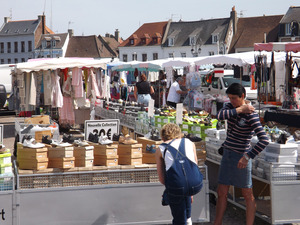 Try staying in the town for a day or two and experience a bit of French rural life. For a small town there are plenty of hotels at good prices. One of them is called the Hotel de France and it is rumoured that Emperor Napoleon stayed there for a night during his travels. Nowadays it looks as though it is about to fall down. It is run by an English couple who have gone totally native and love their changed life. Stay there for a night and enjoy the eccentricity. There are lots of places in Montreuil to keep everyone fed and watered. Enjoy the favourite French pastime of lounging on the terrace with your glass of Cotes de Rhone and watch the world go by in the sunshine.
Try staying in the town for a day or two and experience a bit of French rural life. For a small town there are plenty of hotels at good prices. One of them is called the Hotel de France and it is rumoured that Emperor Napoleon stayed there for a night during his travels. Nowadays it looks as though it is about to fall down. It is run by an English couple who have gone totally native and love their changed life. Stay there for a night and enjoy the eccentricity. There are lots of places in Montreuil to keep everyone fed and watered. Enjoy the favourite French pastime of lounging on the terrace with your glass of Cotes de Rhone and watch the world go by in the sunshine.
It is easy to travel to Montreuil-sur-Mer from the Kent coast. The ferry will take about an hour and a half and then it is easy to continue by car or train. Go just for the day if you want or perhaps stay a little longer. The French people in Montreuil-sur-Mer always welcome British visitors and you will feel very much at home in their elegant little town.


